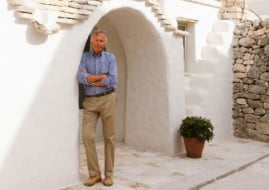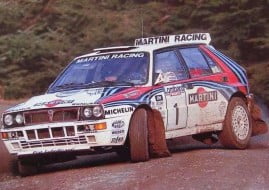Lancia Stratos - Racing Car With a Perfect Score
In the late ’60s and early ’70s, the rising popularity of rally races motivated different manufacturers to introduce specially prepared versions of their production models intended for racing. However, it wasn’t until the middle of the ’70s that there was a vehicle built with only one purpose in mind — to participate in rallies across the globe and win.
Lancia beat the competition
The first factory to pioneer the production of such a car was the legendary Lancia. The company had already tasted big success in rallies with its Fulvia HF, but the competition (Alpina, Ford, and Porsche) had become too strong. Lancia’s solution was to create a new model which would be better and faster than anything that existed.

Lancia Stratos featured wedge-shaped design by Bertone
From concept to race track
In 1970, Bertone introduced a concept car called Stratos. It was very modern looking with extremely advanced design solutions. The concept sparked the imagination of Lancia Rally’s team boss, Cesare Fiorio, who thought that some of the concept’s features could be used on their rally car.
Using his influence in the company, Fiorio gained financial backup for the project but had no basis for the car. The first step was to commission the design and layout of the new model. Naturally, Fiorio chose Betone and instructed them to create a new car with a centrally-positioned engine, small dimensions and a low center of gravity.
The legendary Marcello Gandini was the main creator of the new model and he gave it an everlasting appeal embodied in the perfect mix of aggressive and elegant lines and shapes.

Lancia Stratos on gravel
Lancia and Ferrari together on a mission
The second part of the project was to provide the necessary power, and Lancia just didn’t have an engine good enough for the task. So, Fiorio asked Ferrari to help as he wanted to buy Ferrari’s 2,4 l. V6 unit from Ferrari 246 GT Dino.
Enzo Ferrari was very reluctant at first, thinking that the new Stratos would be a direct competitor to his Dino. But after negotiations, he soon realized that Dino would soon be out of production and so he agreed to sell Lancia enough engines for the start of the production of Stratos. With the final pieces of the puzzle in place, Lancia started working on prototypes and testing.
The official presentation was in 1972 at the Torino Motor Show and the audience was stunned since the new Stratos had a very modern appearance and looked like something out of this world. After the presentation, Lancia began producing Stratos in sufficient numbers for homologation. The FIA limit in those days was 500 copies.

Its technical layout was as dramatic as its design
Humble beginnings but the success was inevitable
The first test of the new Stratos was Tour de Corse in late 1972. However, the beginning of the car’s rally career was hampered by mechanical failures. During 1973, Lancia Rally Team participated in all races with modest success trying to solve technical problems.
It was only in 1974 that the car was fully ready for racing and started dominating the World Rally Championship. The most successful driver of the time was Sandro Munari, Lancia’s factory driver. But lots of private teams bought Stratos and began racing.
Its performance and road holding were sublime. The small V6 had 190 bhp in factory trim but in the hands of rally teams, it developed much more. The small dimensions and weight ensured agility and over the next few years, Stratos was simply unbeatable.

Lancia Stratos’ spartan interior
Perfect score
It is almost impossible to count all victories of Stratos but here are just a few: 18 WRC victories from 1974 to 1981, three times Monte Carlo Rally winner and it even participated in the 24 Hours of Le Mans, although modified from its rally specs.
In the late ’70s, Fiat introduced the 131 Abarth Rally and Lancia introduced the 037 Rally, two models which showed that Stratos was no longer the best. This led to the end of its magnificent career, even though the Stratos was used by some private teams until the early ’80s.

Lancia Stratos in the mud on Acropolis rally
Today, Lancia Stratos is one of the most successful and legendary cars of all times. For a short period of time, it was dominant in WRC and influenced all the following rally cars, and the infamous Group B as well. Stratos might be considered slow by today’s standards, but its legacy will undoubtedly live on forever.
Photo: autowp.ru






